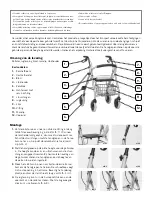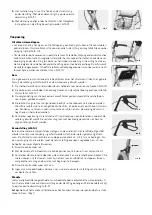
Back rest
You can insert the back rest into the sockets in the tube on the front of the rollator. You can fix it with the enclosed clips
(pic. 5–8).
The back rest is for support when sitting and facilitates comfortable sitting posture during a rest. Always lean slowly and
evenly against it. Do not hang any coats or bags over it.
Care and Maintenance
The rollator may only be used as a walking aid. Keep the rollator free from dirt, so that it remains functional. The rollator
can be cleaned with a neutral cleaning agent and a cloth and then rinsed and dried. Dry the rollator thoroughly after clean-
ing or exposure to rain. The brake pads and springs should also be cleaned regularly. The rollator should
only be disinfected by a specialist. The product can be disinfected with a disinfectant with 70–80 percent
ethanol content. Disinfectants containing chlorine or phenol should not be used. Do not use caustic sol-
vents. Do not use the rollator in temperatures below –35 °C or above +60 °C.
Please find below a maintenance table and hygiene plan for the regular care and maintenance of this device:
–35°C
60°C
Maintenance Table
When
Before every re-use
What
Caution
Check general condition
Visually inspect all frame parts including welded joints for
deformation, damage, wear or corrosion
If you find any defects, replace the affected parts of the
device.
Check hand grips visually and by attempting to turn them
If you find that the hand grips are damaged or no longer
firmly connected to the frame, they must be replaced.
Check the tyre tread and ball bearings
If you find that the wheels are worn or cracked, they must
be replaced.
Check the folding lock
If the folding mechanism no longer works properly, it must
be repaired or replaced.
Check the connecting elements for tightness
If you find that screws, nuts, rivets, etc. are loose or missing
they must be tightened, fitted or replaced.
Check the braking system is working satisfactorily
Apply the operating brake until it reaches the stopping
point. The wheels must not be able to turn now when
pushed hard.
Apply the parking brake by pressing the brake levers down
until it engages.
The wheels must not be able to turn now when pushed hard.
If the brakes are defective, the brake slack, brake cables,
brake shoes and wheels must be checked and the defective
part of the device must be replaced if necessary.
Send your rollator for regular checks to your dealer. He will be able to detect any wear and tear and replace parts, if neces-
sary. If you find the brake action to be faulty in any way, please contact your dealer immediately.
Hygiene Plan
Before each re-use or before each patient change, the rollator is to be disinfected and cleaned.
Disinfection/cleaning
1.
Before preparing the rollator, put on protective gloves and if necessary, protective clothing (disposable apron).
2.
Always disinfect first, then clean. Exception: Severe contamination must be removed before disinfection.
3.
Wipe or spray the rollator with a disinfectant listed by the German Society for Hygiene and Microbiology (DGHM) or
the German Association for Applied Hygiene (VAH) (taking care to follow the manufacturer’s recommended contact
time). Disinfection by wiping is generally preferable to spraying. After the contact time for the disinfectant has elapsed,
dry the rollator off with a clean, dry cloth.
4.
To clean, use water and a mild detergent. No water must be allowed to enter the tubes. Do not use caustic or bleaching
cleaning agents.
After cleaning, dry the rollator off with a clean, dry cloth.

































